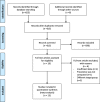Prevalence of anemia among school-age children in Ethiopia: a systematic review and meta-analysis
- PMID: 29793528
- PMCID: PMC5968474
- DOI: 10.1186/s13643-018-0741-6
Prevalence of anemia among school-age children in Ethiopia: a systematic review and meta-analysis
Abstract
Background: Anemia continued to become a major public health problem in developing nations including Ethiopia. Especially, school children are more vulnerable for anemia and consequences of anemia. Generating accurate epidemiological data on anemia in school children is an important step for health policy maker. There are limited evidences on anemia prevalence in school-age children in Ethiopia. This study aimed to synthesize the pooled prevalence of anemia in school-age children in Ethiopia.
Methods: This systematic review and meta-analysis was followed the PRISMA guidelines. Comprehensive searched was conducted in PubMed/MEDLINE, Cochrane Library, Google Scholar, HINARI, and Ethiopian Journal of Health Development for studies published before 2016, supplemented by manual searches to identify relevant studies. Two review authors independently selected studies, extracted data, and assessed quality of studies. The Cochrane Q test and I2 test statistic were used to test heterogeneity through studies. The overall prevalence was calculated using random-effects model of DerSimonian-Laird method.
Results: From 831 obtained studies, 13 articles included in the meta-analysis. The pooled prevalence of anemia among school children in Ethiopia was 23% (95% CI 18-28%). The prevalence of anemia in male and female school-age children was 27% (95% CI 20 and 34%) and 24% (95% CI 18 and 30%), respectively.
Conclusions: This study found that prevalence of anemia was a moderate public health problem in school children. Due to the complications of anemia for school children, preventative planning and control of anemia among school children in Ethiopia is necessary.
Keywords: Anemia; Ethiopia; Iron-deficiency anemia; Prevalence; School children.
Conflict of interest statement
Ethics approval and consent to participate
Not applicable.
Competing interests
The authors declare that they have no competing interests.
Publisher’s Note
Springer Nature remains neutral with regard to jurisdictional claims in published maps and institutional affiliations.
Figures
Similar articles
-
A systematic review and meta-analysis of the prevalence and predictors of anemia among children in Ethiopia.Afr Health Sci. 2020 Dec;20(4):2007-2021. doi: 10.4314/ahs.v20i4.59. Afr Health Sci. 2020. PMID: 34394267 Free PMC article.
-
Male and undernourished children were at high risk of anemia in Ethiopia: a systematic review and meta-analysis.Ital J Pediatr. 2018 Jul 11;44(1):79. doi: 10.1186/s13052-018-0513-x. Ital J Pediatr. 2018. PMID: 29996879 Free PMC article.
-
Burden and determinants of scabies in Ethiopian school age children: A systematic review and meta-analysis with public health implications.PLoS One. 2024 Dec 19;19(12):e0314882. doi: 10.1371/journal.pone.0314882. eCollection 2024. PLoS One. 2024. PMID: 39700220 Free PMC article.
-
Burden of anemia and its association with HAART in HIV infected children in Ethiopia: a systematic review and meta-analysis.BMC Infect Dis. 2019 Dec 4;19(1):1032. doi: 10.1186/s12879-019-4656-1. BMC Infect Dis. 2019. PMID: 31801471 Free PMC article.
-
Prevalence of iodine deficiency and associated factors among school-age children in Ethiopia: a systematic review and meta-analysis.Syst Rev. 2024 May 30;13(1):142. doi: 10.1186/s13643-024-02567-4. Syst Rev. 2024. PMID: 38816755 Free PMC article.
Cited by
-
Prevalence and classification of anemia among children in Sudan: a systematic review and meta-analysis.J Med Life. 2024 Aug;17(8):761-768. doi: 10.25122/jml-2023-0441. J Med Life. 2024. PMID: 39539427 Free PMC article.
-
Prevalence of Anemia among Children and Adolescents of Bangladesh: A Systematic Review and Meta-Analysis.Int J Environ Res Public Health. 2023 Jan 18;20(3):1786. doi: 10.3390/ijerph20031786. Int J Environ Res Public Health. 2023. PMID: 36767153 Free PMC article.
-
Anemia Predicts Physical Fitness Among Adolescent Athletes in Ghana.Health Sci Rep. 2024 Dec 9;7(12):e70243. doi: 10.1002/hsr2.70243. eCollection 2024 Dec. Health Sci Rep. 2024. PMID: 39659821 Free PMC article.
-
Anaemia and associated factors among children aged 6-59 months during the post-ebola period in Sierra Leone: a national cross-sectional survey- 2019.Arch Public Health. 2024 Sep 14;82(1):156. doi: 10.1186/s13690-024-01290-9. Arch Public Health. 2024. PMID: 39277757 Free PMC article.
-
Anemia and Associated Factors among Public Elementary School Children in Asella Town, Southeast Ethiopia: A Facility-Based Cross-Sectional Study.Anemia. 2024 Apr 24;2024:1519382. doi: 10.1155/2024/1519382. eCollection 2024. Anemia. 2024. PMID: 38694783 Free PMC article.
References
-
- Benoist BD, McLean E, Egll I, Cogswell M. Worldwide prevalence of anaemia 1993-2005: WHO global database on anaemia. Geneva: WHO global database on anaemia; 2008.
-
- Adem OS, Tadsse K, Gebremedhin A. Iron deficiency aneamia is moderate public health problem among school going adolescent girls in Berahle district, afar, Northeast Ethiopia. J Food Nutr Sci. 2015;3:10–16. doi: 10.1002/fsn3.183. - DOI
-
- Charles CV. Iron deficiency Anemia. In: Maddock PJ, editor. A public health problem of global proportions. 2012.
-
- World Health Organization. Iron deficiency anaemia: assessment, prevention and control. A guide for programme managers. Geneva: World Health Organization; 2001.
-
- Mathers C, Steven G, Mascarenhas M. Global health risks: mortality and burden of disease attributable to selected major risks. Geneva: World Health Organization; 2009.
Publication types
MeSH terms
LinkOut - more resources
Full Text Sources
Other Literature Sources
Medical



